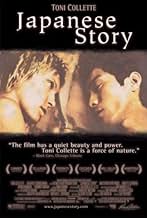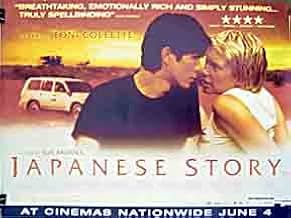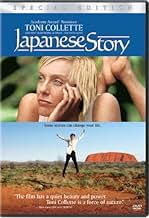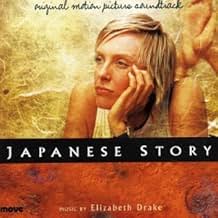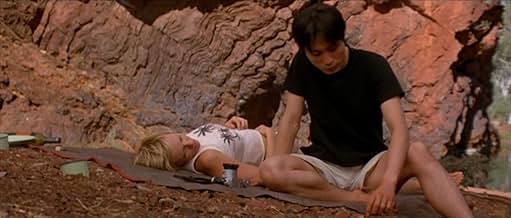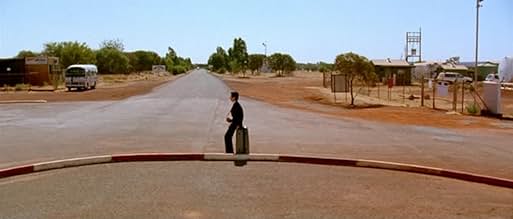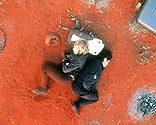IMDb RATING
6.8/10
6.9K
YOUR RATING
Against the background of an Australian desert, Sandy, a geologist, and Hiromitsu, a Japanese businessman, play out a story of human inconsequence in the face of the blistering universe. The... Read allAgainst the background of an Australian desert, Sandy, a geologist, and Hiromitsu, a Japanese businessman, play out a story of human inconsequence in the face of the blistering universe. The end of the journey leaves no one capable of going back to where they started from.Against the background of an Australian desert, Sandy, a geologist, and Hiromitsu, a Japanese businessman, play out a story of human inconsequence in the face of the blistering universe. The end of the journey leaves no one capable of going back to where they started from.
- Awards
- 20 wins & 13 nominations total
Jules Hutchinson
- Canteen Worker
- (as Jules Hutchison)
- Director
- Writer
- All cast & crew
- Production, box office & more at IMDbPro
Featured reviews
I don't know what to expect when I went to see "Japanese Story" - I didn't read any review other than hearing Toni Collette did a terrific job and the trailer is interesting. I sensed that the element of 'death' could be part of the theme/plot as I noted at a beginning scene where Sandy (Collette's character) was sitting down reading papers in her Mum's kitchen and her Mum casually remarked that death is part of life. A brief notion and director Sue Brooks continues on letting us follow Sandy around: at her office, we see her modern geological double-monitor workstation; we hear her frustrated exchange with male business partner on 'dumping' her the task of handling business client arriving from Japan. We follow her home still vexed at the agonizing thought of accompanying a Japanese client - meanwhile we're shown how matter of fact she goes about getting her chow down, with new age gadgets like a self-rotating can opener. The screen cuts to a small airfield. We see an Oriental man (Gotaro Tsunashima) in suits steps off a plane. The air about him is detached. The contrast is felt when Collette arrives in a hurry, disheveled appearance and in casual slacks. So the journey of this odd pair begins. A fascinating one at that.
It may not be apparent immediately that you'd be experiencing an emotional ride. But I found the pace just right - right there in the outback environment with the two of them, day, night, very hot, shivering cold, sweating, digging. There's a certain atmosphere to the film - can't quite label it but definitely Australian geographical-oriented - land, nature and people. Thrown into the mix is the Japanese culture for added spice, thoughtfully put together. Hence the joy, jumping for joy, laughter, joking, gentleness, intimacy, we'd understand. The turn of events edifies how unexpected life can be - the yin and yang, the ecstasy and sadness, just at the change of a moment, a motion stunned, numb. The mystery of life and death is utterly incomprehensible by man. The focus is not on grief or state of shock, nor simply on cultural differences, the aim seems further: it almost culminates in the words about the joy given to him, the chance to appreciate the vastness of the space (desert), and being able to open his heart.
The two Japanese roles were well cast: Gotaro Tsunashima as Hiro performed pitch perfect. The role of the wife by Yumiko Tanaka, though brief, is important to complement Collette's role. Both gave just the right dose and tempo to the characters.
The Australian landscape is simple yet breathtaking. Cinematographer Ian Baker and film editor Jill Bicock are both from Australia and had worked together on "IQ" 1994 and "A Cry in the Dark" 1988. Music by Elizabeth Drake and casting by Dina Mann both are former collaborators with the team of Brooks, Tilson and producer Sue Maslin in 1997 ("Road to Nhill").
The film reminds me of w-d Friðriksson's "Cold Fever" (1995) and w-d Clara Law's "The Goddess of 1967" (2000). The former is a road movie of a young Japanese businessman traveling to Iceland to observe tradition and honor his dead parents; the latter is an Australian made film with outback landscapes and an intriguing non-conforming story.
Kudos to Alison Tilson who has written an insightful script, and Sue Brooks who has confidently directed this film made in "forty days and forty nights in the desert." Production by Gecko Films, Australia, and distribution by Samuel Goldwyn Films, U.S., "Japanese Story" is a thought-provoking film to experience.
It may not be apparent immediately that you'd be experiencing an emotional ride. But I found the pace just right - right there in the outback environment with the two of them, day, night, very hot, shivering cold, sweating, digging. There's a certain atmosphere to the film - can't quite label it but definitely Australian geographical-oriented - land, nature and people. Thrown into the mix is the Japanese culture for added spice, thoughtfully put together. Hence the joy, jumping for joy, laughter, joking, gentleness, intimacy, we'd understand. The turn of events edifies how unexpected life can be - the yin and yang, the ecstasy and sadness, just at the change of a moment, a motion stunned, numb. The mystery of life and death is utterly incomprehensible by man. The focus is not on grief or state of shock, nor simply on cultural differences, the aim seems further: it almost culminates in the words about the joy given to him, the chance to appreciate the vastness of the space (desert), and being able to open his heart.
The two Japanese roles were well cast: Gotaro Tsunashima as Hiro performed pitch perfect. The role of the wife by Yumiko Tanaka, though brief, is important to complement Collette's role. Both gave just the right dose and tempo to the characters.
The Australian landscape is simple yet breathtaking. Cinematographer Ian Baker and film editor Jill Bicock are both from Australia and had worked together on "IQ" 1994 and "A Cry in the Dark" 1988. Music by Elizabeth Drake and casting by Dina Mann both are former collaborators with the team of Brooks, Tilson and producer Sue Maslin in 1997 ("Road to Nhill").
The film reminds me of w-d Friðriksson's "Cold Fever" (1995) and w-d Clara Law's "The Goddess of 1967" (2000). The former is a road movie of a young Japanese businessman traveling to Iceland to observe tradition and honor his dead parents; the latter is an Australian made film with outback landscapes and an intriguing non-conforming story.
Kudos to Alison Tilson who has written an insightful script, and Sue Brooks who has confidently directed this film made in "forty days and forty nights in the desert." Production by Gecko Films, Australia, and distribution by Samuel Goldwyn Films, U.S., "Japanese Story" is a thought-provoking film to experience.
The best thing about `Japanese Story,' an Australian film directed by Sue Brooks and set almost entirely in the Outback, is its unpredictability. Just as you begin to think that the story, written by Alison Tilson, is headed in one particular direction, it does an amazing about-face and leads us down an entirely different, utterly unexpected narrative path.
The movie starts off as a fairly standard romantic comedy, involving two strangers who don't like each other very much yet who are forced to spend an inordinate amount of time together. Sandy is a geologist whose company, against her will and better judgment, has asked her to escort an important Japanese businessman through the wilds of the Australian desert on a sightseeing tour. The film even begins to seem a bit like a landlocked `Swept Away' for awhile, as these two headstrong people he a Japanese traditionalist with male chauvinistic tendencies and she a no-nonsense, freethinking, independent woman (but both filled with doubts and insecurities beneath the surface) find themselves stranded in a hostile and remote environment, fighting for survival. But then the first of the film's numerous plot reversals kicks in and we find ourselves in an entirely different situation altogether.
I certainly don't want to spoil anyone's experience of this film by revealing just what those plot twists are, so I will merely state that the film, in the second half, becomes a fairly profound meditation on the precarious nature of life and the almost lightning-paced speed with which tragedy can intervene to bring our worlds crashing down around us. Toni Collette is heartbreaking as the feisty yet warmhearted Sandy and Gotaro Tsunashima is both tender and stoic as the man from an exotic culture with whom she eventually falls in love.
That, of course, is the predictable part. But if you think you know where this story is going, you will be pleasantly surprised at how wrong you will be.
The movie starts off as a fairly standard romantic comedy, involving two strangers who don't like each other very much yet who are forced to spend an inordinate amount of time together. Sandy is a geologist whose company, against her will and better judgment, has asked her to escort an important Japanese businessman through the wilds of the Australian desert on a sightseeing tour. The film even begins to seem a bit like a landlocked `Swept Away' for awhile, as these two headstrong people he a Japanese traditionalist with male chauvinistic tendencies and she a no-nonsense, freethinking, independent woman (but both filled with doubts and insecurities beneath the surface) find themselves stranded in a hostile and remote environment, fighting for survival. But then the first of the film's numerous plot reversals kicks in and we find ourselves in an entirely different situation altogether.
I certainly don't want to spoil anyone's experience of this film by revealing just what those plot twists are, so I will merely state that the film, in the second half, becomes a fairly profound meditation on the precarious nature of life and the almost lightning-paced speed with which tragedy can intervene to bring our worlds crashing down around us. Toni Collette is heartbreaking as the feisty yet warmhearted Sandy and Gotaro Tsunashima is both tender and stoic as the man from an exotic culture with whom she eventually falls in love.
That, of course, is the predictable part. But if you think you know where this story is going, you will be pleasantly surprised at how wrong you will be.
"Japanese Story" is a fascinating exploration of gender and cultural roles, with a more incisive take on the contrasts than "Lost in Translation," let alone than in the simplicity of "The Last Samurai."
The Australian outback is a harsher but beautiful landscape of blokes and sheilas than the Manhattan of "Sex and the City" but it brings into relief similar questions of expectations of guys and gals in life and sex.
Toni Colette's "Sandy" is one tough geologist required to guide Gotaro Tsunashima to his father's company's environment-destroying mining businesses. Each suspiciously views the other through narrow stereotypical lenses that block out the complexities of their real lives and potential.
They very gradually adapt to each other, opening each other up to new experiences in quite unexpected ways, even though their language and life communication is still limited. She is the shaggy, physical, confident one; he is the smooth, intellectual, diffident one. "Sandy" is aggressive in a way much more typical of males in U.S. movies, while "Tachibana" is redolent of the farm wife in "The Bridges of Madison County."
The third act is even more startling in its catharsis for "Sandy" as she finds inner strengths and vulnerabilities to deal with her responsibilities across the cultural chasm.
The Australian outback is a harsher but beautiful landscape of blokes and sheilas than the Manhattan of "Sex and the City" but it brings into relief similar questions of expectations of guys and gals in life and sex.
Toni Colette's "Sandy" is one tough geologist required to guide Gotaro Tsunashima to his father's company's environment-destroying mining businesses. Each suspiciously views the other through narrow stereotypical lenses that block out the complexities of their real lives and potential.
They very gradually adapt to each other, opening each other up to new experiences in quite unexpected ways, even though their language and life communication is still limited. She is the shaggy, physical, confident one; he is the smooth, intellectual, diffident one. "Sandy" is aggressive in a way much more typical of males in U.S. movies, while "Tachibana" is redolent of the farm wife in "The Bridges of Madison County."
The third act is even more startling in its catharsis for "Sandy" as she finds inner strengths and vulnerabilities to deal with her responsibilities across the cultural chasm.
10Adetunji
This is, apparently, a love it or hate it movie. As is the case with such films those on one side have a hard time understanding the view of the opposite. I am fully in that camp, I thought this film was stark and beautiful--as moving in its silence and mundane moments as it was illuminating. For those who say there is no plot, well I clearly saw a different film, there is more story and intention in simple small details as there are in a whole series of other films. Toni Collette was amazing and Gotaro Tsunashima was perfect, capturing the emotional compression and exploration of his character with clarity and skill. In a film full of striking absolutely believable and full moments -- the furtive exploratory glances as the two leads drive through the desert, and Toni's fascination with Gotaro's nearly hairless arms say so much about the characters', their history, their assumptions, their prejudices. Incredibly moving, shattering emotionally, and ultimately deeply profound. A haiku-like meditation on living and sharing--I loved it.
In an age when criticism has become debased and few people are really certain about what constitutes true worth in art, it is difficult to use the word "masterpiece" about any film. And yet that word is applicable here. At first this film appears to be just a bog-standard romantic love story, in the Hollywood mould, about two very different characters who meet and fall in love in unusual circumstances. Opposites attract, and so on.
However, as the story unfolds one becomes aware that there are many more levels to it than one would normally expect. Everything, from the title to incidental characters and the spectacular images of the desert, has been carefully thought out. It raises profound questions about a fashionable subject: identity, but also about love itself. Are these characters in love, or is it merely the terrifying starkness of the Australian outback that has thrown them together? Finally a third person enters the relationship, who complicates matters even further. Despite the romantic overtones of this film it is lifted, ultimately, by its absolute realism. Small gestures betoken whole story lines and glimpses of other characters throw the protagonists into sharp relief. Other influences begin to trickle through: Yasujiro Ozu, Peter Weir (in his early days), Japanese Haiku. And yet this is an entirely original work.
This film had a huge emotional impact on me, but it also made me think, about my own life and about the choices I've made. It did everything that a genuine work of art should do, and without any of the fanfare that we, in the West, have come to associate with art. Small wonder that it got little of the attention that in previous eras it would have attracted. Watch it, and discover that it is still possible to make a classic.
However, as the story unfolds one becomes aware that there are many more levels to it than one would normally expect. Everything, from the title to incidental characters and the spectacular images of the desert, has been carefully thought out. It raises profound questions about a fashionable subject: identity, but also about love itself. Are these characters in love, or is it merely the terrifying starkness of the Australian outback that has thrown them together? Finally a third person enters the relationship, who complicates matters even further. Despite the romantic overtones of this film it is lifted, ultimately, by its absolute realism. Small gestures betoken whole story lines and glimpses of other characters throw the protagonists into sharp relief. Other influences begin to trickle through: Yasujiro Ozu, Peter Weir (in his early days), Japanese Haiku. And yet this is an entirely original work.
This film had a huge emotional impact on me, but it also made me think, about my own life and about the choices I've made. It did everything that a genuine work of art should do, and without any of the fanfare that we, in the West, have come to associate with art. Small wonder that it got little of the attention that in previous eras it would have attracted. Watch it, and discover that it is still possible to make a classic.
Did you know
- GoofsWhen the QANTAS jet to Kyoto leaves, it is actually leaving from the Perth domestic airport. The international terminal, where it would really leave from, and the Darling Ranges to the east, are clearly visible in the background.
- Crazy creditsOur thanks to the people of Nyamal, Ngarluma, Yinjibarndi, Bunjima and Nyiparli Nations.
- ConnectionsFeatured in Inside Japanese Story: an evening with the film-makers (2004)
- SoundtracksABC News Theme
(1986)
Written by Tony Ansell (as T. Ansell) and Peter Wall (as P. Wall)
Published by ABC Music Publishing and
Kindly reproduced with the permission of the Australian Broadcasting Corporation
- How long is Japanese Story?Powered by Alexa
Details
- Release date
- Country of origin
- Official sites
- Languages
- Also known as
- Японская история
- Filming locations
- Production companies
- See more company credits at IMDbPro
Box office
- Budget
- $5,740,000 (estimated)
- Gross US & Canada
- $647,054
- Opening weekend US & Canada
- $23,962
- Jan 4, 2004
- Gross worldwide
- $4,098,613
- Runtime1 hour 46 minutes
- Color
- Sound mix
- Aspect ratio
- 2.35 : 1
Contribute to this page
Suggest an edit or add missing content








